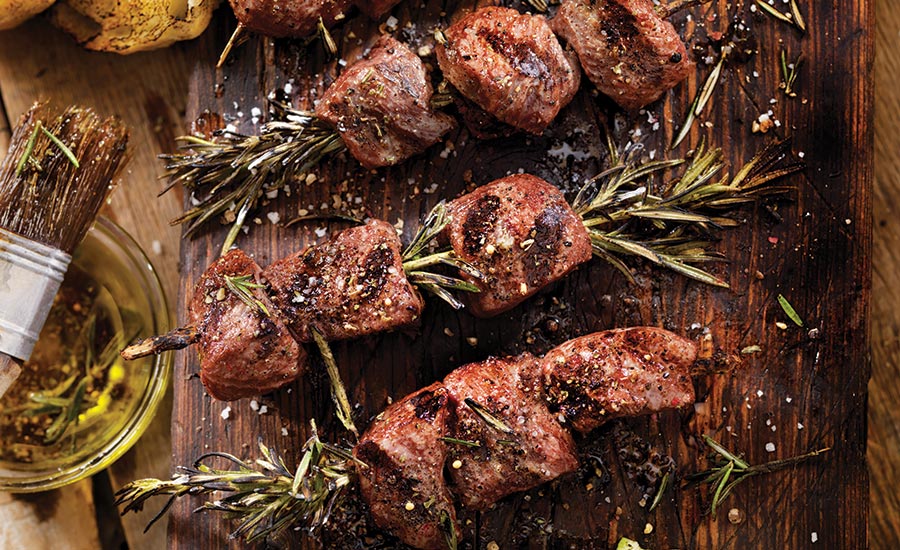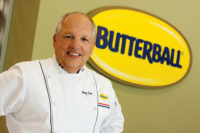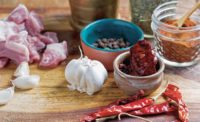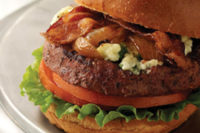Wet and Dry: A Barbecue Story
The American love affair with barbecue is still on fire

PHOTO COURTESY OF: J&J Group LLC/Rufus Teague BBQ and Meat Sauces (www.rufusteague.com)
Barbecue is the great American religion and each region prays in its own way. And the hymns of flavor are represented in the dry rubs and the wet rubs, the marinades before the fire, and the sloppy, saucy slatherings applied after.
The components that go into building good barbecue flavors run from a few simple spices and herbs to vinegars and reductions of wines and spirits. Sauces can be basic or complex, with chili peppers, tomatoes, fruits, vegetables, and other ingredients creating a whole that is greater than the sum of its parts. Yet bringing recipes from the back yard to the production line without losing quality or authenticity, and balancing flavors with smoke and time, call for an adept hand.
Table of Contents
Today’s approach to barbecue is being heavily influenced, as it was in its origins, by a “nose to tail” movement that focuses on the entire animal, not just the tender cuts. It is from these tougher and more sinewy cuts, such as the shoulder and brisket, that the cooking methods and flavors of good old-fashioned barbecue built its history.
Tougher cuts of animal protein need longer and slower cooking in order to break down collagen, melt fats, and render skin. Indirect and lower-heat cooking methods prevent these cuts from drying out and becoming undesirable. This method also allows for the use of stronger and more flavorful spice blends and marinades.
Rubs and marinades are commonly packed with flavor, but the ingredients and their flavors burn or fall off the meat when using direct-heat cooking methods. This is particularly the case with high-heat grilling.
There’s the Rub
The world of barbecue today has witnessed an explosion of dry rubs and marinades. Rubs still are considered one of the most consistent ways of infusing desired flavors into good barbecue.
One of the main characteristics that distinguishes a rub from a typical seasoning mix is the fact that there is a lower proportion of salt, ounce for ounce, in a dry rub blend. This allows the pitmaster to use more of the spice mix to season, which builds up the flavor and helps build a nice crust in the process. This crust is also known as the “bark” because a good bark resembles the bark of a tree.
One of the most important factors to take into consideration when using either a dry rub or a marinade is the proportion of salt or, more accurately, the sodium content in the formula. The higher the concentration of sodium, the less amount of time the protein remains in contact with it. This is because a high concentration of salt results in a more “cured” texture, similar to deli-style lunch meat. This, of course, is not a desirable characteristic in good barbecue.

Marinades by nature run off on the grill, but adding a rub of powdered versions of the same ingredients, such as soy sauce, keeps flavors bold.
PHOTO COURTESY OF: Kikkoman Corp. (www.kikkoman.com)
A marinade delivers flavor by surrounding the protein in a flavorful oil or other fat medium, usually for a couple of hours. This type of flavoring method only penetrates the meat to about ¼ of an inch from the surface, so an intensely flavored marinade is needed to adequately deliver the required flavor profile.
Sauces and basting “mops” typically are used as a finishing note. They are designed to complement a well-seasoned, slow-cooked piece of meat. These products usually are constructed as a “flavor ladder.” They deliver a good balance of punchy top-note flavors to “zing around the palate.” Their flavor hits the taste buds with immediacy and then quickly fades away. Common components are vinegars, fruit juices, chili peppers, and herbs.
Next on this ladder are the structure-building “middle note” flavors. These are made of ingredients that are subtler and won’t linger on the palate much. They are composed of more mild-tasting ingredients, and only come through after cooking, marinating, smoking, or some other method breaks down their components to release the flavor. Vegetables, starches, fats, and sweeteners fulfill this function.
Finally, there are the deep “bass note” flavors. These are the flavors that are only noticed through their absence, if they are missing from the final product. Typically umami, they comprise the “je ne sais quoi” of the flavor world: The consumer can’t put a finger on what the flavor is, but can tell there is something providing a more solid underpinning. Think of mushrooms, soy sauce, tomatoes and tomato concentrates, or mustard when developing this level.
All these different flavor levels combine to create what becomes a signature flavor, one that is highly individual from pitmaster to pitmaster. It is this endless combination that gives us the myriad of flavors in the simple category of rubs and sauces.
Between the dry rub and the marinade is the “wet” rub. A wet rub is simply a dry rub with a little added moisture that creates a paste. The paste can be on the dry side and slightly crumbly, or somewhat wetter and thus “painted” on the meat or other item slated for the barbecue.
Popular moist ingredients used to make a wet rub run from such items as mustard or honey (or sometimes both) to beer, wine, bourbon, or other alcohol-containing liquids. And, with the fast-rising trend of global barbecue, sriracha has proven to be a popular ingredient in a number of new barbecue product releases.
Global Outlook
Emerging flavor trends from other countries are bringing their versions of rubs, mops, and sauces with them. Among the most popular of late is Korean barbecue. Korea has a big barbecue tradition.
Ingredients typically used in a classic Korean gogi gui include short ribs that are marinated in a mixture of soy sauce and toasted sesame oil with garlic and pepper or onion, and sweetened with sugar. Another typical Korean barbecue dish makes use of thinly sliced sirloin or flank steak marinated in a mixture based on the currently trendy red chili, rice powder, and fermented soy paste called gochujang.
A primary factor that processors must take into account in barbecuing is that of loss of product weight during the cooking process. When barbecue is done properly, the loss due to moisture evaporation and fat rendering can run from a third to almost half of total weight. This equates to almost double the cost of the main component.
One increasingly popular way to mitigate this is to cook sous vide, that is, in heat-proof, vacuum-sealed plastic packets. This technique is excellent for not only reducing loss and maintaining a consistent cook, but also for keeping in flavor and moisture. However, it does very little for maintaining authentic barbecue attributes.
The common workaround is to grill or griddle the product in a final cooking step. While this still impacts authenticity, it can create a perfectly suitable and flavorful product for mass production. When cooking sous vide, it is important to note that lower amounts of spices and other flavorants are needed, as they will dissolve into the juices and fats that render out and redistribute through the meat in a concentrated form.
South America, too, is a recently flourishing source of barbecue culture, with Brazil and Argentina represented by a string of upscale QSRs focusing on pit- and rotisserie-cooked meats. While beef is the preferred animal protein in South American cuisine, lamb, poultry, and pork are being put to the fire for US consumption.
These churrascaria, as the venues are properly called, focus intently on the meat itself, usually seasoned only with salt and, if chicken is involved, perhaps some red pepper sauce. Flavor is added at the tables with plenty of vegetable side dishes and condiments such as chimichurri sauce, classically a mix of finely minced parsley and oregano, oil, puréed or minced garlic, red chili flakes, and red wine vinegar.
As global flavor trends continue to spread, so do barbecues from countries and regions such as the Philippines, South Africa, the Caribbean, and the Middle East. The variety of meats and sauces and rubs putting these barbecue styles on the map are readily available for product makers to try their hand at adding them to the mix of offerings in this rapidly expanding landscape.
A Leg Up
The best cuts for great barbecue are some of the toughest muscle cuts. There is a saying: “The closer to the feet, the better the barbecue.” These “worked” cuts of meat have well-developed fibers and connective tissue, and the most flavor.
Brisket—the part of the lower chest that’s close to the forefeet—possesses enough flavor that it can be boldly spiced and smoked, yet the meat still will outshine the most strongly flavored rubs. On the other hand, the tenderloin—a cut from the upper back near the lumbar—has a quite mild flavor, is very low in fat, and is better complemented with a sauce or other condiment.
In addition to the brisket, some of the best cuts of beef for barbecue are the shoulder, short ribs, and the upper portion of the rear leg—flank, shank, plate, and round. The best cuts of pork for barbecue are the shoulder, ribs, and the upper part of the rear leg, or the ham.
From chicken and other poultry, the best cut is the leg meat, both thigh and drumstick. Lean toward these cuts for consistent barbecue every time. (For more detailed information on the best cuts of beef, see “It’s About the Meat,” below.)
Building Flavor
When creating a rub, mop, or sauce, it is imperative to use the highest quality ingredients. Another consideration when evaluating the ingredients is the viscosity that each one has. A marinade of thin liquids and subtle flavors is best suited for a thinner, more tender cut of meat that can absorb the flavors and spend less time cooking, since the marinade ingredients will run off easily and what remains will dissipate quickly.
Thicker and more viscous components, such as tomato concentrate or mustard, can balance out thinner juices, alcohol-containing liquids, and sweeteners when building the formula. Alternatively, a developer may use concentrates and extracts to get more flavor per ounce.

When crafting a rub, mop, or sauce, the viscosity of each ingredient must be considered to achieve desired performance from the final product.
PHOTO COURTESY OF: TIC gums (WWW.TICGUMS.COM)
These thicker formats of flavorants can deliver the same taste impact while maintaining a consistency that will adhere to the meat. An example would be a maple concentrate or extract instead of straight maple syrup, or a beer flavoring that can substantially reduce the volume of liquid added to a marinade without sacrificing flavor.
The same approach can be taken with a dry rub. Using low-quality ingredients will only result in off flavors and, in many cases, more expense. A dry rub is simply that—dry spices mixed together that are supposed to be rubbed into and stuck to the meat. If some of the spices are low quality and don’t have a strong flavor, more of the rub will be required to obtain the desired result than if using a freshly ground equivalent.
An important part of a good rub is that it doesn’t fall off. While for the backyard barbecuer (for whom an uneven result won’t be a picnic table deal-breaker), this can be achieved by pressure from rubbing the dry mixture into the surface of the meat, that method is less suitable for batch production. Applying a sticky coating or “glue” to keep the dry rub on the surface of the meat throughout the cooking process can do the trick.
Across the US, culinary influences from Mexican to Native American to African to Middle European have splattered the country’s different regions with distinct sauces to go with the locally preferred meats.
Even within some states, sauce types split along divisive lines. For example, in the Carolinas, while vinegar-strong sauces tend to be the rule, the Eastern half of North Carolina uses apple cider vinegar as a base to support peppers (both black and red) and red-hot sauce. In the Western side of the state, it’s not uncommon for ketchup to be added to the above mix. South Carolinans go for the gold—Carolina Gold—with a thin, vinegary mustard sauce and a hint of spices. Pork, specifically larger cuts of pork such as the butt or shoulder, are featured.
Kansas City barbecue sauce is perhaps the most popular in the rest of the country. Although hundreds of variations exist, KC sauces are the heavy, sweet and smoky brown sauces that include ketchup and molasses or brown sugar or even maple. KC sauces are usually used on beef and poultry but pork ribs, too, are a common vehicle.
Texas barbecue is a different breed of cat. Or beef, rather. Beef is nearly the exclusive animal protein for the Great State’s barbecue. And as for sauce... don’t. A true Texas barbecue gets a rub of just two ingredients, salt and pepper, with the craftsmanship of flavor coming from the wood (mesquite is common) and the technique. If sauce must be included, it usually serves as a condiment, and typically is a thinner, spicier version of a Kansas City-style sauce.
In the competition barbecue world, common ingredients include mayonnaise or, more frequently, a mild mustard. This would be slathered all over the meat and then the rub would be applied. An important characteristic of a sticky pre-rub coating is that it is as flavorless as possible, allowing the dry rub to take center stage.
Such pre-rub coatings usually dehydrate during the cooking process, but by then, the spices and sugars have set into the meat, creating a desirable bark that barbecue aficionados crave. However, another approach is to bring added flavor notes to the final product by using a liquid that converts a dry rub to a wet rub as described above.
Consistency
After formulating a perfect barbecue rub, the developer will typically work though some benchtop samples and various cooking methods. Once the desired results are achieved, a pilot trial is next. At this stage, some concessions might be necessary to create a safe and consistent barbecue program in the plant.
Unfortunately, a crispy bark isn’t easily attainable in large-volume operations. The process of cooking, chilling, and packaging safely will simply soften the crust too much. It is better to strive for an optimal, consistent flavor and texture. In some cases, packaging instructions can be provided that will allow the final preparer to set the bark during the reheating process.
Adding the finishing sauce or mop that will wrap up the cooking process is another occasion to include the operator in the final preparations. This is because finishing the meat with sauce and then packaging it will dilute the flavorful sauce with juices from the meat and lead to significant flavor loss.
A better approach is to package the cooked barbecue in one container and provide the sauce in a separate container with instructions for the finishing step in the package. This also allows for customization by the final preparer, enabling them to craft points of differentiation in the served product.
Ring True
A final technical aspect to consider is the “smoke ring”. This is a thick red line that naturally occurs in the cooking chamber when the hemoglobin in the meat reacts with the carbon monoxide that wood produces when it combusts and gives off smoke and heat. This red ring around the outside of the meat has become the hallmark for the consumer’s perception of good barbecue.
If the production operation does not have the capacity to provide the step of combusting wood during the cooking process, there are alternatives that can replicate the process. One of the most common methods is that of including nitrates in the seasoning.
For those processors desiring a nitrate-free product, a concentrated beet juice bath—or even a dilute red food colorant bath—can mimic the desired look. All these methods should be applied only lightly. With any of them, is easy to over-color the meat, which will be obvious to the consumer and could lead to rejection.
While these techniques will approximate the color that is the standard, they still cannot compare to the natural coloring imparted by the traditional process. This can only be authentically created through wood combustion.
At the same time, it’s unavoidable that authentic techniques will carry a higher price tag. These considerations come into play when contemplating, pricing, and marketing a barbecue product. Often, even some of the best high-volume production results cannot quite reach those of the backyard barbecue engineer. But when paired with a carefully made finishing sauce or mop, a barbecue experience that rises above the competition can be readily achieved, and the meal will become memorable.
by Lenny Lebovich
Creating barbecued beef products for eventual reheating by an end user can be tricky. If overcooked, the beef can be grey, tough to chew, and have an off flavor. Since most beef lovers enjoy their steaks medium rare, sous vide is a reliable and consistent method for par-cooking steak before finishing it off (see above).
For a pulled barbecue beef product, chuck roll subprimals are the best option. Chuck roll, when cooked “low and slow” or under pressure, provides excellent flavor and shreds easily for melt-in-the-mouth tender beef that holds sauce well. Trim excess fat from chuck rolls and place in tumblers with seasoning. For sous vide pre-preparation, vacuum seal the beef in heat-safe bags and process.
Another pre-prep option is to pressure-cook the beef for a shorter amount of time than with the sous vide method. Once cooked, open bags, shred meat, and add sauce. Hot-fill containers and chill quickly to below 40°F or pack into trays to be sealed and frozen.
For steaks, belt charbroiling works well to retain color and flavor, while also applying grill marks and allowing slight caramelization. New York strips, rib eyes, and filet mignons are among the best options for single-serving steaks. The steak can then be placed in the sous vide film or pouch and sealed. Sauces or other flavorings can be added at this step or included separately in the meal for the consumer to add at home.
Lenny Lebovich is founder and CEO of PRE Brands (www.eatpre.com), a Chicago-based premium packaged fresh foods brand on a mission to bring consumers the world’s best beef, sold nationally at retail and online. Lebovich provides expert insights that help makers of prepared beef products optimize the consumer eating experience. He can be reached at llebovich@eatpre.com
Originally appeared in the May, 2018 issue of Prepared Foods as Wet and Dry: A Barbecue Story.
Looking for a reprint of this article?
From high-res PDFs to custom plaques, order your copy today!





